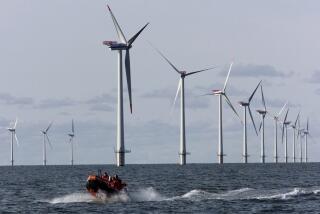Planners Say No to Wind Farm in Hills Near Gorman : Panel Cites Harm to Birds, Rustic Scenery
- Share via
Los Angeles County planners on Wednesday rejected a proposal to build the county’s first power-generating wind farm in the hills northeast of Gorman.
The five-member Regional Planning Commission said the project would destroy the rustic beauty of the area, promote erosion and harm wildlife, after one protester warned that the spinning blades of giant turbines would slice up passing birds “like they went through a Cuisinart.”
The commission unanimously voted down the proposal after a five-hour hearing attended by more than 150 people at Santa Clarita City Hall.
Zond Systems, the largest producer of wind energy in California, had hoped to erect more than 300 windmills--some as high as 150 feet--on vacant, mountainous land near the tiny community best known as a truck stop along Interstate 5, south of the Kern County line.
Zond’s proposal drew opposition from a broad coalition that included the California Department of Fish and Game, the National Audubon Society, the Sierra Club, a citizens group called Save the Mountain Committee, and Tejon Ranch, a wealthy landowning corporation with 200,000 acres in the area.
Ralphs Family
Tehachapi-based Zond had the backing of the influential Ralphs family, a pioneer Gorman clan that founded the supermarket chain. The proposal had divided the small town--Gorman has only 65 registered voters--for months. The Save the Mountain Committee circulated petitions throughout the county and submitted more than 3,000 signatures opposing the windmills.
The commissioners heard often-conflicting testimony during the hearing.
Zond officials cited an environmental impact report that declared that the $100-million project would not significantly harm wildlife or the environment. The report said the proposed site was outside the routes usually traveled by the endangered California condor. The giant condor is now confined to captivity, but scientists hope to reintroduce the birds to the region in the early 1990s.
But Linda Blum of the National Audubon Society said the windmills would raise a dangerous barrier in a former condor “flyway.” Sherry Teresa, a wildlife biologist with the state Department of Fish and Game, said the environmental impact report was deficient. She said it failed to note that three endangered species--the bald eagle, peregrine falcon and Swainson’s hawk--have been sighted at the proposed wind farm site.
Russell Hemsath, speaking for the California State Racing Pigeon Organization, said, “Our birds would look like they went through a Cuisinart.”
But Steven W. Carothers, an environmental consultant for Zond, countered that the number of birds killed by windmills statewide is “relatively insignificant.”
Zond President James Dehlsen tried to persuade the commissioners by touting windmills as clean producers of energy that would reduce pollution and the use of gas and oil. ‘We like to think we’re practicing environmentalists,” he said.
But commissioners rejected his argument, saying their concern was land use, not utility bills.
Zond had originally proposed building 458 windmills but scaled that proposal down to 350. Dehlsen offered to cut back the proposal to 319 so that none of the giant machines would be visible from Interstate 5, a common complaint by the project’s critics.
Commissioners were not swayed. ‘I really have a problem with this project,” Commissioner Betty Fisher said.
Commissioner Lee Strong agreed that the site was ill-suited to a wind farm but said that much of the opposition probably came from landowners with their own development plans. Referring to the parade of paid experts who testified for the opponents, Strong said: ‘You can’t tell me that the money that has been spent comes strictly from the people. It’s coming from people who are concerned about ‘what is going to happen to my piece of property?’ ”
Dehlsen said it was too soon to predict whether Zond would appeal the commission’s decision to the Board of Supervisors.
More to Read
Sign up for Essential California
The most important California stories and recommendations in your inbox every morning.
You may occasionally receive promotional content from the Los Angeles Times.










